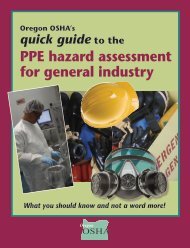Technical Manual - Section 3 (Safety Hazards)
Technical Manual - Section 3 (Safety Hazards)
Technical Manual - Section 3 (Safety Hazards)
Create successful ePaper yourself
Turn your PDF publications into a flip-book with our unique Google optimized e-Paper software.
LUBRICANT, WAX, AND GREASE<br />
MANUFACTURING PROCESSES<br />
Lubricating oils and waxes are refined from the residual<br />
fractions of atmospheric and vacuum distillation. The primary<br />
objective of the various lubricating oil refinery processes is to<br />
remove asphalts, sulfonated aromatics, and paraffinic and<br />
isoparaffinic waxes from residual fractions. Reduced crude<br />
from the vacuum unit is deasphalted and combined with<br />
straight-run lubricating oil feedstock, preheated, and<br />
solvent-extracted (usually with phenol or furfural) to produce<br />
raffinate.<br />
WAX MANUFACTURING PROCESS<br />
Raffinate from the extraction unit contains a considerable<br />
amount of wax that must be removed by solvent extraction<br />
and crystallization. The raffinate is mixed with a solvent<br />
(propane) and precooled in heat exchangers. The<br />
crystallization temperature is attained by the evaporation of<br />
propane in the chiller and filter feed tanks. The wax is<br />
continuously removed by filters and cold solvent-washed to<br />
recover retained oil. The solvent is recovered from the oil by<br />
flashing and steam stripping. The wax is then heated with hot<br />
solvent, chilled, filtered, and given a final wash to remove all<br />
oil.<br />
LUBRICATING OIL PROCESS<br />
The dewaxed raffinate is blended with other distillate<br />
fractions and further treated for viscosity index, color,<br />
stability, carbon residue, sulfur, additive response, and<br />
oxidation stability in extremely selective extraction processes<br />
using solvents (furfural,<br />
phenol, etc.). In a typical phenol unit, the raffinate is mixed<br />
with phenol in the treating section at temperatures below 400º<br />
F. Phenol is then separated from the treated oil and recycled.<br />
The treated lube-oil base stocks are then mixed and/or<br />
compounded with additives to meet the required physical and<br />
chemical characteristics of motor oils, industrial lubricants,<br />
and metal working oils.<br />
GREASE COMPOUNDING<br />
Grease is made by blending metallic soaps (salts of<br />
long-chained fatty acids) and additives into a lubricating oil<br />
medium at temperatures of 400-600º F. Grease may be either<br />
batch-produced or continuously compounded. The<br />
characteristics of the grease depend to a great extent on the<br />
metallic element (calcium, sodium, aluminum, lithium, etc.)<br />
in the soap and the additives used.<br />
SAFETY AND HEALTH CONSIDERATIONS<br />
Fire Protection and Prevention<br />
The potential for fire exists if a product or vapor leak or<br />
release in the lube blending and wax processing areas reaches<br />
a source of ignition. Storage of finished products, both bulk<br />
and packaged, should be in accordance with recognized<br />
practices.<br />
While the potential for fire is reduced in lube oil blending,<br />
care must be taken when making metal-working oils and<br />
compounding greases due to the use of higher blending and<br />
compounding temperatures and lower flash point products.<br />
Table III:2-22 LUBRICATING OIL AND WAX MANUFACTURING PROCESSES<br />
Feedstock From Process Typical products................To<br />
Lube Vacuum tower, solvent Treatment Dewaxed raffinate............. Lube blend or<br />
compound<br />
feedstock dewaxing, hydrotreating Grease compounding<br />
and solvent extraction, etc. Wax............................... Storage or shipping<br />
additives<br />
III:2-48
















